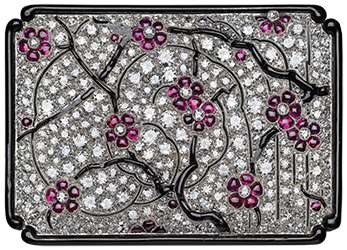|
Legacy
The Best of Paris
Lacloche Frères was among the upper echelon of Art Deco firms, producing jewelry and objets d’art.
By Phyllis Schiller

|
| Diamond, platinum and gold Japanesque brooch with ruby and onyx by Lacloche Frères, circa 1925. William Francis Warden Fund; Photograph © Museum of Fine Arts, Boston. |
The house of Lacloche Frères was founded in Madrid in 1875 by four brothers — Leopold, Jacques, Jules and Fernand Lacloche. “There is still a lot to be learned about Lacloche Frères. It’s the pieces that seemed to have survived, not the history,” notes Peter Shemonsky, private jeweler and jewelry historian in San Francisco, California. “I have seen late-nineteenth-century pieces that were signed Lacloche Frères Madrid — silver-topped, gold-backed diamond corsage ornaments in the flavor of the day, beautiful, but not extraordinary.”
It wasn’t until the brothers went to Paris that they produced the pieces that are so prized today. When Jacques died in 1900, the Madrid branch was closed and all three brothers set up shop on the Rue de la Paix in Paris. In 1920, they bought out Fabergé’s inventory in London, establishing their presence in two of the cultural centers on the Continent. In 1925, Lacloche Frères exhibited at the Arts Décoratifs exhibition in Paris, showing a series of pendants whose designs were inspired by the fables of La Fontaine. By the 1930s, the Paris store on Rue de la Paix was closed. In 1935, Jacques Lacloche II opened a store in Cannes and later a shop in Paris under the name of SARL Jacques Lacloche. By the 1960s, the business had closed. It was during the early Paris years, however, that the firm established its stellar reputation for high Art Deco jewelry.
The heyday of Lacloche Frères, confirms Simon Teakle, of Simon Teakle Fine Jewelry, Greenwich, Connecticut, was during the Art Deco period. “The jewelry and objects from the 1920s and 1930s were breathtaking. The firm drew on the very best designs and outstanding workmanship of the period and produced really beautiful jewelry.”
In the 1920s, says Carol Elkins, senior vice president, Sotheby’s jewelry department, “two pivotal events occurred: The discovery of King Tutankhamen’s tomb in 1922 and the Paris Exposition of 1925, where everything really cuts loose in terms of design.” And Lacloche Frères drew on both seminal events.
Along with jewelry, continues Elkins, the firm produced various types of “necessaires, compacts and vanity cases. This is an area in which it excelled.” Another iconic piece, she says, was its pictorial strap bracelet. One with an Egyptian Revival motif sold for over a million dollars at Sotheby’s New York in December 2014. “Lacloche used other sources of inspiration, such as Oriental art, but Egyptian motifs seem to be the ones that have come on the market more in recent times.”
Teakle says he’s had two stellar examples of Oriental-themed pictorial bracelets in his store —“one depicting a river scene with a pagoda, the other a floral motif. When I had the opportunity to purchase them, I jumped at it.”
A brooch with an Oriental motif, shown above, has found a place in the Museum of Fine Arts, Boston. It depicts a Japanese cherry blossom tree, its gracefully twinning branches made of onyx, says Emily Stoehrer, the museum’s Rita J. Kaplan and Susan B. Kaplan Curator of Jewelry. “The flat Deco brooch has a painterly quality that doesn’t go out of style. It could have been worn at the waist, similar to a bejeweled buckle.” The piece also has an impressive provenance; it was given by Queen Mary in 1952 to Angela Lascelles on her marriage to the Queen’s cousin.
One of the reasons Lacloche jewelry stands out, says Shemonsky, is the use of multiple colored gemstones and enamel. “So many times when you see their calibre work, whether in a floral motif or depicting an Egyptian Revival motif or an Oriental motif in the Art Deco style, there are a lot of buff-top colored stones. It gives the piece a particular dimension and that’s one of the hallmarks of Lacloche jewelry.”
“During the 1920s, Lacloche Frères used a strong color palette and vibrant enamels and gemstones,” points out Lisa Stockhammer-Mial, president of online retailer The Three Graces. “It was very much a part of its repertoire.”
According to Russell Fogarty, of Kazanjian & Fogarty, Beverly Hills, California, when he thinks about Lacloche, it’s about the firm’s “Art Deco jewelry and objects with intricate inlay detailing and enamel work. The pieces sometimes tell a story with small colored stones that are buff-topped and cut just so. There were no big Kashmir sapphires or Burma rubies, but occasionally, there will be a nice diamond, but not a giant one. Lacloche’s business was made, I think, in the creation of jewels that were little works of art.”
Both jewelry and objets d’art are out there, says Shemonsky, “but they come with a high price, especially if they are highly collectible Art Deco–themed pieces.” The pictorials, says Elkins, are fewer in number than other bracelets “and rarity always goes to value at the end of the day.”
There is always a market for the name Lacloche at auction, sums up Elkins. “It holds value thanks to the quality of the craftsmanship. This is French design at its best. Lacloche represents the apex of jewelry designers producing around the period circa 1925 and has an appeal that persists today.”Article from the Rapaport Magazine - September 2015. To subscribe click here.
|
|